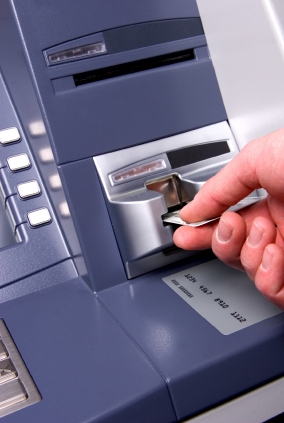ATM Scams
ATM scams have been around for almost as long as ATM's [automated teller machines]have been in existence.
Most people use ATM's to some extent for their financial transactions, therefore potentially exposing millions of people to ATM fraud.
The most common type of ATM scam is called skimming where a scammer places a device over the ATM card entry slot and reads the information on the magnetic strip when you insert your card.
The scammer also conceals a pinhole camera on the ATM to record you entering your PIN.
There have also been cases of the ATM being fake - it will appear to process your transaction, but won't dispense any cash to you. There is usually a laptop placed inside to capture your information.
How ATM Scams Work
Card skimmers and how they work is covered in our page on skimming.
In some cases, a transparent plastic overlay on the keypad can record your PIN as it is entered, so don't use keypads with a plastic overlay over them.
Once your card information has been copied off the magnetic strip, the scammers can clone the credit or debit cards. The cards are then used to steal money from your account, or make purchases with your cloned card.
The low tech type of ATM scams are when people hang around ATMs in order to try to steal your card or withdraw money. They can tamper with the ATM so that your card gets stuck when you try to use it.
If you leave your card after entering your PIN they may be able to withdraw cash. Sometimes a 'helpful' person may give advice and tips to help you withdraw the card, including entering your PIN a couple of times. When you give up, they remove the card, and use your PIN they saw you entering.
The scammers may work in pairs with one of them 'bumping' into you, and then the other one telling you the person who just bumped into you has stolen your card. If you try to run after them, the second person will then use your card that is still in the machine to withdraw cash, as you have already entered your password.
The University of Texas has some photos of the equipment installed for skimming with ATM scams.
Protecting Yourself from ATM Scams

The scammers use sophisticated technology which is getting harder to detect, so it is not easy to protect yourself.
- There are a few tell-tale signs however that you should look for that indicate that an ATM has been tampered with. If the machine has an unusual looking card reader, for example, if it has an extension added to it then don’t use the ATM machine
- Look for any small cameras, mirrors or look behind brochure holders, or deposit slip holders attached to the ATM
- If you use the ATM and your card is rejected but you are offered no explanation as to why your card was rejected then the machine may have been tampered with and you will need to contact your bank
- Look to see if the keypad has a plastic overlay on it, and if it does, don't use the ATM as the overlay could be a skimming device used to capture your PIN
- If your account is debited for the cash withdrawal but you didn’t get any cash from the ATM machine then you need to contact your bank immediately
- Be on the alert for suspicious people or vehicles in the vicinity of the ATM as the scammer will usually be within a couple of hundred yards in order to receive the transmitted information from the card skimmer
- Don't accept help from anyone around the ATM
- Cover the keypad with your hands when you enter your PIN in case there are any hidden cameras around
- We recommend that you save all the bank and credit card [those you carry] companies’ phone numbers on your cell phone. If you then encounter a problem such as a stuck card, you don't need to leave the ATM to call and cancel your card
The process of skimming credit card and debit card information does not only occur with ATM scams. Credit card readers at kiosk services and gas pumps can also be targeted for this type of scam. Always regularly check your statement for fraud after every transaction.
- Home ›
- Credit Card Scams ›
- ATM Scams